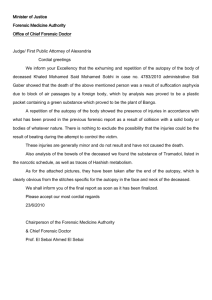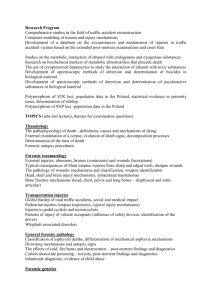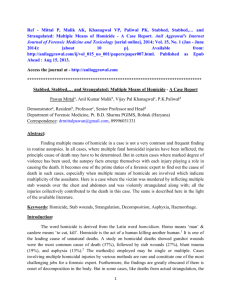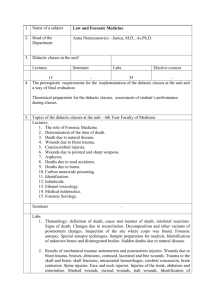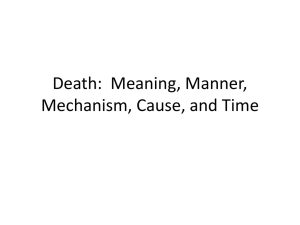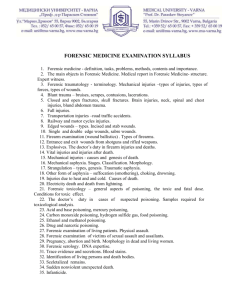Suicidal cut-throat and stab fatalities: three case reports
advertisement
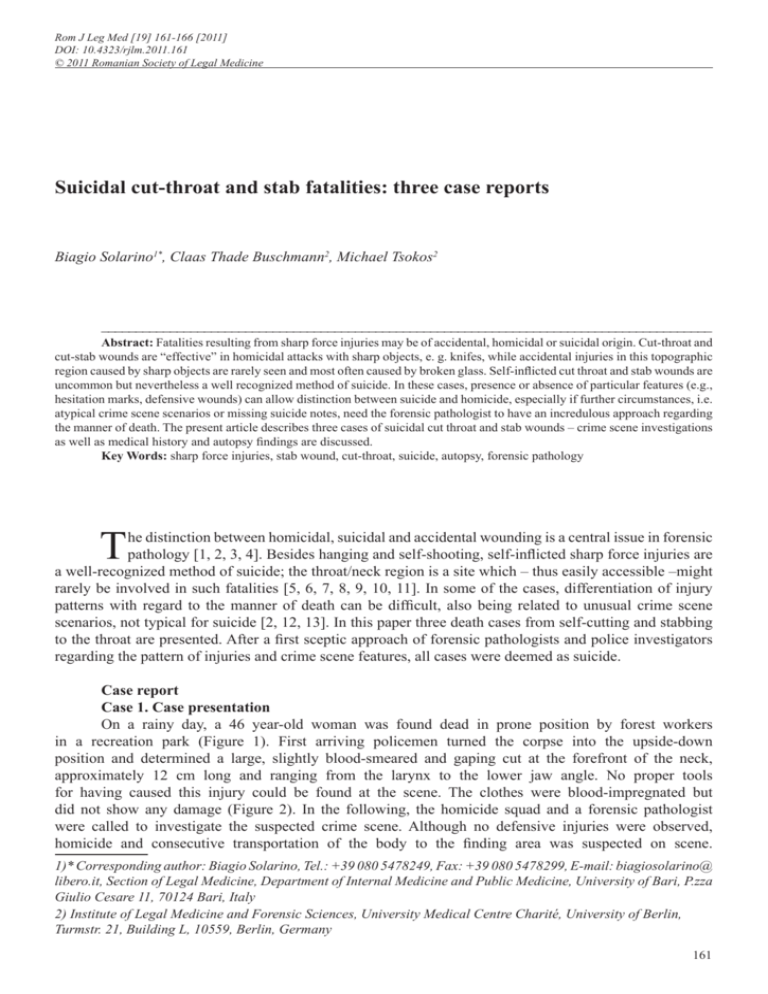
Rom J Leg Med [19] 161-166 [2011] DOI: 10.4323/rjlm.2011.161 © 2011 Romanian Society of Legal Medicine Suicidal cut-throat and stab fatalities: three case reports Biagio Solarino1*, Claas Thade Buschmann2, Michael Tsokos2 _________________________________________________________________________________________ Abstract: Fatalities resulting from sharp force injuries may be of accidental, homicidal or suicidal origin. Cut-throat and cut-stab wounds are “effective” in homicidal attacks with sharp objects, e. g. knifes, while accidental injuries in this topographic region caused by sharp objects are rarely seen and most often caused by broken glass. Self-inflicted cut throat and stab wounds are uncommon but nevertheless a well recognized method of suicide. In these cases, presence or absence of particular features (e.g., hesitation marks, defensive wounds) can allow distinction between suicide and homicide, especially if further circumstances, i.e. atypical crime scene scenarios or missing suicide notes, need the forensic pathologist to have an incredulous approach regarding the manner of death. The present article describes three cases of suicidal cut throat and stab wounds – crime scene investigations as well as medical history and autopsy findings are discussed. Key Words: sharp force injuries, stab wound, cut-throat, suicide, autopsy, forensic pathology T he distinction between homicidal, suicidal and accidental wounding is a central issue in forensic pathology [1, 2, 3, 4]. Besides hanging and self-shooting, self-inflicted sharp force injuries are a well-recognized method of suicide; the throat/neck region is a site which – thus easily accessible –might rarely be involved in such fatalities [5, 6, 7, 8, 9, 10, 11]. In some of the cases, differentiation of injury patterns with regard to the manner of death can be difficult, also being related to unusual crime scene scenarios, not typical for suicide [2, 12, 13]. In this paper three death cases from self-cutting and stabbing to the throat are presented. After a first sceptic approach of forensic pathologists and police investigators regarding the pattern of injuries and crime scene features, all cases were deemed as suicide. Case report Case 1. Case presentation On a rainy day, a 46 year-old woman was found dead in prone position by forest workers in a recreation park (Figure 1). First arriving policemen turned the corpse into the upside-down position and determined a large, slightly blood-smeared and gaping cut at the forefront of the neck, approximately 12 cm long and ranging from the larynx to the lower jaw angle. No proper tools for having caused this injury could be found at the scene. The clothes were blood-impregnated but did not show any damage (Figure 2). In the following, the homicide squad and a forensic pathologist were called to investigate the suspected crime scene. Although no defensive injuries were observed, homicide and consecutive transportation of the body to the finding area was suspected on scene. 1)* Corresponding author: Biagio Solarino, Tel.: +39 080 5478249, Fax: +39 080 5478299, E-mail: biagiosolarino@ libero.it, Section of Legal Medicine, Department of Internal Medicine and Public Medicine, University of Bari, P.zza Giulio Cesare 11, 70124 Bari, Italy 2) Institute of Legal Medicine and Forensic Sciences, University Medical Centre Charité, University of Berlin, Turmstr. 21, Building L, 10559, Berlin, Germany 161 Solarino B et al Suicidal cut-throat and stab fatalities: three case reports Hours later, the handbag of the deceased as well as a slightly blood-smeared single-edged kitchen knife (blade length 15 cm, blade width 3 - 3.5 cm, on one side polished, probably broken off point) was found by police dogs in a shrubbery located 4 – 5 m beneath the position of the deceased. As the woman could be identified then, police investigations showed that she was announced missing by her husband 24 hours before. Autopsyfindings Autopsy yielded fatal exsanguinations through a transverse, 12 cm long throat cut with – after cleaning of the wound area – several, typical hesitation marks in the sharp pointed wound angles. Skin, subcutaneous tissue and superficial musculature (platysma) was cut as well as the right jugular external vein. Preparation of arterial and venous neck vessels did not show further injuries (Figure 3-4). Toxicological blood samples were without relevant findings. Further police investigations revealed that the woman was affected by major depression; she had already expressed suicide intentions and communicated that, in case of committing suicide, she would prefer the birthday of her husband (which was the day of her discovery in the park) to do so. When searching the apartment of the deceased policemen found her diary with the last entry: “Garbage to garbage. Craze me not. You are free”. The case was closed by the public prosecutor’s office. Figure1. Case 1 - Finding scenario of the deceased in prone position Figure2. Case 1 - Throat cut of approximately 12 cm length Figure3-4. Case 1 - Autopsy findings: cleaned, suicidal throat cut with manifold hesitation marks Case 2. Case presentation A 30 year old man was found dead by neighbors, lying in prone position in a large blood puddle in the corridor of his apartment (Figure 5). The door was opened, the entire entrance area of the apartment was blood-smeared; behind the right foot of the corpse a single-edged butcher’s knife with a blade length of approx. 15 cm was found (Figure 6). The living-room next to the corridor showed a blood puddle in the 162 RomanianJournalofLegalMedicine Vol. XIX, No 3(2011) middle, approx. 6 – 7 m away from the position of the corpse with many bloodstain trails on the floor and in the wardrobe, pointing towards to corridor. Because of the opened door, homicide was suspected, and a forensic pathologist was called to investigate the scene. At the first on-scene-examination of the corpse a gaping, approx. 17 cm long throat cut was found. After cleaning the wound area, latter hesitation marks were detected around the defect. A farewell letter was not found, defensive wounds were not present. Autopsyfindings On external examination, signs of hemorrhagic heart failure by fatal exsanguinations from the cut throat were observed: left sternocleidomastoid muscle and large parts of the soft tissue of the neck were dissected, the trachea was opened. No signs of blood aspiration were found, although right carotid commune artery was also partly wounded by sharp force action. Despite right jugular external vein was dissected, no air embolism could be detected. The throat wound showed typical self-inflicted hesitation marks (superficial, parallel, sharp-forced skin cuts) (Figure 7). Furthermore, two stab wounds ending at the right processus transversus of the 7th body of the vertebral column were diagnosed. Autopsy consisted of no other specific findings, toxicological blood samples via GC-MS showed an acute cannabis intoxication (35,67 ng/ml) and a pre-existing cannabis abuse (∆9-Tetrahydrocannabinol of 9,34 ng/mg hair). Police investigations showed the man had behaved strangely before, e.g. running around disoriented and naked, he also underwent a stationary drug withdrawal months before. Furthermore he suffered from a paranoid psychiatric illness. Forensic reconstruction of the blood trails at the scene suggested that, after having cut his throat in the living room, the man possibly opened his apartment door trying to receive help before he fell down and died from exsanguinations. The case was closed by the public prosecutor’s office. Figure6. Case 2 - Knife (blade length 15 cm) found near the feet of the deceased Figure 5. Case 2 - Finding scenario of the corpse in a large pool of blood with opened apartment door Figure7. Case 2 - Autopsy finding: gaping throat cut with stab lesion and hesitation marks 163 Solarino B et al Suicidal cut-throat and stab fatalities: three case reports Case3.Casepresentation A 30 year old man was found dead in his water-filled bath tub by his girlfriend. Before, she was worrying as she could not reach him for several days, thus the fire-brigade was requested for door opening. On a small table in the bathroom two knifes were found, the smaller one (blade length 7 cm, blade width 1 - 1.5 cm, on one side polished) was blood-smeared. The right neck was injured by a stab wound (Figure 8). No hesitation marks in the surrounding tissue were found, but both wrists showed multiple, superficial and sharp-forced tentative cuts which were up to 13 cm long (Figure 9). A farewell letter was not found. Because of the regularly locked door, a forensic pathologist was not called to the scene. Although organic and/or psychiatric diseases were denied by the relatives, the girlfriend remarked a “negative mood” with the man, but no concrete suicide intentions were noticed. Autopsyfindings Autopsy showed fatal hemorrhagic shock from a 2 cm long stab wound in the neck below the lower jaw angle, cutting the right jugular external vein and damaging the right carotid commune artery, also causing severe soft tissue damage. Furthermore, signs of cerebral air embolism were found. The stab wound showed typical morphologic aspects of sharp force, e.g. plain limited and pointed wound margins. Apart from skin maceration on the palmary sites of his hands (“washer-woman’s skin”) from lying in the bath tub, no further organ changes of substantial kind were found. Toxicological blood examinations consisted of no results. The case was closed by the public prosecutor’s office. Figure8. Case 3 - Stab wound on the right side of the neck Figure 9. Case 3 - Multiple, superficial sharp forced hesitation cuts on the wrist of the left arm Discussions Cut-throat injuries and stab wounds to the neck are often fatal in homicidal attacks involving sharp objects, while accidental incised wound of the neck and throat area are commonly reported when persons fall on / through glass materials (e.g. glass doors, glass windows, drinking glasses, mirrors etc. pp.) [2, 14, 15]. Nevertheless self-inflicted sharp force injuries of the neck are an uncommon but well recognized method in suicidal fatalities. The distinction between homicidal, suicidal and accidental injuries is not an easy task for forensic pathologists who need to evaluate neck injuries case by case. 164 Romanian Journal of Legal Medicine Vol. XIX, No 3(2011) Thus, finding scene investigation, the deceased’s medical history as well as all autopsy and toxicological findings must be considered with skeptical approach before being able to establish the manner of death [16, 17]. In particular initial crime scene scenarios might be unspecific and thus mislead latter investigations by wrong starting hypothesis. In case 1 and case 2, death scene investigation initially suggested homicide. The hidden and secluded place where the woman’s corpse was accidentally discovered by forest workers as well as the distance from the body in which the knife and the bag were found, were not particular features leading to assumption of suicide. Moreover no relevant blood-puddles or tracks were found nearby the cadaver or on the knife – due to the rain. Also in case 2, the position of the deceased’s corpse just behind the opened house door was unusual, strongly suggesting an attempt to call for help by the victim, not typical in suicide fatalities. Toxicological proof of cannabis abuse is not a specific feature of suicide. In case 3, the corpse was found naked in a water-filled bath tub, however the presence of the fatal stab wound to the neck in absence of associated tentative incisions that were indeed located in the wrists, could also indicate an attempt to simulate a suicide by a perpetrator. Although our first approach has been incredulous regarding the manner of death, all cases were deemed as suicide after autopsy, coupled with complete crime scene and homicide squad investigation. Self-inflicted cutting or stabbing injuries do show specific patterns. Suicidal incised neck wounds are typically multiple, being characterized by a number of fore-going cuts at the upper end of the wound (tentative injuries/hesitation marks). Their presence suggests self-infliction, indicating repeated attempted cuts being stopped because of pain or hesitancy before finally cutting through the skin [18, 19, 20, 21]. In these victims, hesitant superficial and parallel marks on other accessible parts of the body are frequently seen – sometimes it is possible to observe scarring of the wrists from previous suicide attempts. Another aspect of self-inflicted injury is represented by the fact that cut or stab wounds are usually sustained on sites that are easily accessible, not covered by clothing or on sites exposed after the clothing are pulled out. The absence of defensive wounds which, by definition, will occur in homicidal context when a victim raises the hands / arms for protection or tries to grab the weapon or the perpetrator’s weapon-holding hand is another important feature in sustaining the suicide hypothesis. In all the cases here presented we found different patterns of vital hesitation marks localized at the neck as well as in both wrists in case 3. No defense injuries, normally located on the hands and forearms, were found. A farewell letter was discovered in the first case while in the other two cases, the victims’ medical history indicated paranoid psychiatric illness and depressive behavior – however a clear reason for committing suicide was not stated. The clothing did not show any kind of damage which is commonly observed in homicidal fatalities. Regarding to autopsy findings in the first case the wound at the throat was moderately deeper to cut the right jugular external vein while it was enough deep (case 2) to open the trachea, right carotid commune artery and jugular external vein. Very uncommon were the findings of two stabbing wounds ending at the process transverses of the 7th body of the vertebral column, probably following the neck wound; this bizarre action might have occurred as a sequence of cannabis abuse and psychiatric illness. In the third case the stab wound of the throat damaged the right jugular vein and carotid commune. The superficial hesitations marks localized in both wrists were characteristic for suicide. Dealing with the crime scene scenario we emphasize that the first two victims were found about not far the place where the fatal injuries were sustained. Recent literature reports that a person whose carotid is cut is able to move for at least 10 m [22-23]. In case 1 only the jugular vein was cut – the victim was able to survive for minutes. In all cases neither indications of a perpetrator’s action such as a signs of fight or particular bloodstain tracks were found. In conclusion we emphasize that homicide might be initially suspected in cases of self-inflicted throat sharp force injuries nevertheless the presence of characteristic features assists in correctly establishing the manner of death. 165 Solarino B et al Suicidal cut-throat and stab fatalities: three case reports References 1. DiMaio VJ, DiMaio D. Wounds caused by pointed and sharp-edged weapons. In: Di Maio VJ, Di Maio D Forensic Pathology, 2nd edn. CRC Press, Boca Raton. 1998, p. 187–228. 2. Karlsson T. Homicidal and Suicidal Sharp Force Fatalities in Stockholm, Sweden. Orientation of Entrance Wounds in Stabs Gives Information in the Classification. Forensic Sci Int. 1998; 93: 21–32 3. Spitz WU. Sharp force injury. In: Spitz WU, Spitz and Fisher’s medicolegal investigation of death, 4th edn. Charles C Thomas, Springfield. 2006. p. 532–606. 4. Bohnert M, Hüttemann H, Schmidt U. Homicides by sharp force. In: Tsokos M,. Forensic pathology reviews, Humana Press Inc, Totowa. 2005. p. 65–89 5. Byard RW, Klitte A, Gilbert JD, James RA. Clinicopathologic features of fatal self-inflicted incised and stab wounds: a 20-year study. Am J Forensic Med Pathol. 2002; 23:15-18 6. Karlsson T, Ormstad K, Rajs J. Patterns in sharp force fatalities - a comprehensive forensic medical study: Part 2. Suicidal sharp force injury in the Stockholm area 1972-1984. J Forensic Sci. 1988; 33:448-461. 7. Chadly A, Marc B, Paraire F, Durigon M. Suicidal stab wounds of the throat. Med Sci Law. 1991; 31:355–356. 8. Fukube S, Hayashi T, Ishida Y, Kamon H, Kawaguchi M, Kimura A, Kondo T. Retrospective study on suicidal cases by sharp force injuries. J Forensic Leg Med. 2008;15:163-167. 9. Hasekura H, Fukushima H, Yonemura I, Ota M. A rare suicidal case of a ten-year-old child stabbing himself in the throat. J Forensic Sci. 1985; 30:1269–1271. 10. Jović R. Suicidal knife injuries of the neck. Med Pregl. 1996; 49:308-312. 11. Start RD, Milroy CM, Green MA. Suicide by self-stabbing. Forensic Sci Int. 1992;56: 89–94. 12. Karger B, Niemeyer J, Brinkmann B. Suicides by sharp force: typical and atypical features. Int J Legal Med. 2000; 113: 259–262. 13. Shetty BS, Padubidri JR, Bhandarkar AM, Shetty AJ, Shetty M. “Atypical Suicidal” cut throat injury--a case report. J Forensic Leg Med. 2009;16:492-493. 14. Demirci S, Dogan KH, Gunaydin G. Throat cutting of accidental origin. J Forensic Sci. 2008; 53:965-967. 15. Fracasso T, Karger B. Two unusual stab injuries to the neck: homicide or self-infliction? Int J Legal Med. 2006:120;369-371. 16. Ohshima T, Kondo T. Eight cases of suicide by self-cutting or stabbing: consideration from medico-legal viewpoints of differentiation between suicide and homicide. J Clin Forensic Med. 1997; 4:127–132. 17. Rouse DA. Patterns of stab wounds: a six-year study. Med Sci Law. 1994: 34:67–71. 18. Schmidt U, Pollak S. Sharp force injuries in clinical forensic medicine-findings in victims and perpetrator. Forensic Sci Int. 2006: 159:113–118. 19. Racette S, Kremer C, Desjarlais A, Sauvageau A. Suicidal and homicidal sharp force injury: a 5-year retrospective comparative study of hesitation marks and defense wounds. Forensic Sci Med Pathol. 2008; 4:221–227. 20. Vanezis P, West IE. Tentative injuries in self stabbing. Forensic Sci Int. 1983;21:65–70. 21. Bhullar DS, Aggarrwal KK. Medico-legal diagnosis & pattern of injuries with sharp weapons. JIAFM. 2008: 29:112-114. 22. Sauvageau A, Trepanier JS, Racette S. Delayed deaths after vascular traumatism: two cases. J Clinical Forensic Medicine. 2006;13:344-348. 23. Karger B, Niemeyer J, Brinkmann B. Physical activity following fatal injury from sharp pointed weapons. Int J Legal Med 1999; 112:188–191. 166
